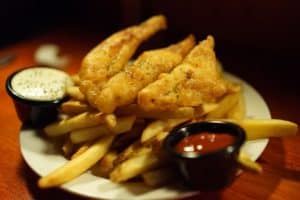 Shrimp scampi, beer-battered fish and some types of cheese dips all have one thing in common: alcohol in the recipe. Most of the time, a food that uses alcohol during cooking is considered harmless, at least where blood alcohol concentration (BAC) is concerned. A 2016 claim by a Wisconsin man that his 10th OWI was the result of beer-battered food was dismissed by a jury; by the time the food was fully cooked (in this case, deep-fried), the alcohol content was negligible. Most of the time, that is the case, especially when cooking with beer, wine or liquor. But there are some recipes where the alcohol isn’t “cooked out” enough, making a favorite dessert or culinary treat a danger if you will be driving.
Shrimp scampi, beer-battered fish and some types of cheese dips all have one thing in common: alcohol in the recipe. Most of the time, a food that uses alcohol during cooking is considered harmless, at least where blood alcohol concentration (BAC) is concerned. A 2016 claim by a Wisconsin man that his 10th OWI was the result of beer-battered food was dismissed by a jury; by the time the food was fully cooked (in this case, deep-fried), the alcohol content was negligible. Most of the time, that is the case, especially when cooking with beer, wine or liquor. But there are some recipes where the alcohol isn’t “cooked out” enough, making a favorite dessert or culinary treat a danger if you will be driving.
Your BAC could be affected by your alcohol-flavored food, depending on how it is cooked.
Obviously, the high heat of a deep fryer would have a different effect on BAC than a quick flambé. The USDA reports that 30 minutes of baking with alcohol only reduces the BAC in food by 30 percent. So, you may think you’re only flavoring your food with a touch of alcohol when the reality is you could be increasing your chances of drunk driving. Also, it may be relevant to point out that even in the case of the beer-battered OWI defense, the accused clearly knew he was consuming a product with alcohol. It wasn’t in a liquid form, but alcohol is alcohol – whether in a dessert, a shot at the bar, or even in a powdered form. Too much alcohol can lead to bad decisions, drunk driving and a potential ignition interlock requirement, too.
As a cautionary tale, beer-battered anything isn’t a good defense if your BAC is above the legal limit. Furthermore, if your food contains alcohol, you still have to consider whether you’re safe to drive. Eating alcohol isn’t any different than drinking alcohol, it just takes on a different flavor of its own; one that can leave a bad taste if it leads to drunk driving and other risks on the road.

Leave a Reply
You must be logged in to post a comment.